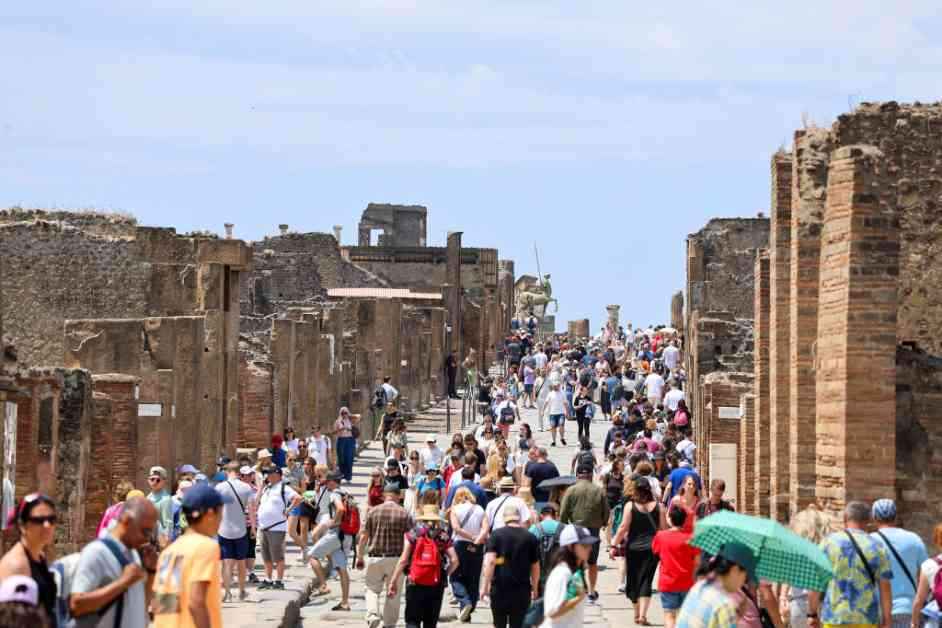Pompeii: An Engaging Journey through Time
In 79 C.E., the ancient city of Pompeii, nestled just 14 miles southeast of Naples, was a vibrant and opulent resort town under the Roman Empire. Originally settled by the Osci, an ethnic group that eventually became part of the empire, Pompeii thrived as a haven for the Roman elite. Stone-paved streets lined with shops, restaurants, bathhouses, and even an arena that could accommodate 20,000 spectators painted a picture of luxury and leisure. The city was a bustling hub of activity, known for its export of grapes and olives thanks to the fertile volcanic soil surrounding it.
Pliny the Younger, a witness to the city’s tragic demise, noted minor tremors in the days leading up to the catastrophic eruption of Mount Vesuvius. However, these tremors were a common occurrence, and thus did not raise concern among Pompeii’s 10,000 to 20,000 residents. When Vesuvius finally erupted, the disaster unfolded in two stages, the first sending ash and pumice raining down on the city. Most of the inhabitants, alarmed by the ominous plume and destruction, managed to flee. The following day, a pyroclastic flow engulfed Pompeii, resulting in the tragic death of an estimated 2,000 people, with many of the victims immortalized in subsequent archaeological excavations.
The ruins of Pompeii remained hidden until the 18th century, when they were finally unearthed, revealing an astonishing level of preservation and human-shaped voids in the volcanic ash. This discovery captured the public’s imagination, reigniting a widespread interest in ancient history that influenced various forms of art, literature, and architecture.
### The Preservation Mystery of Pompeii
Pompeii’s exceptional preservation can be attributed to the pyroclastic flow that buried the city under 20 feet of ash and debris, effectively freezing it in time. This catastrophic event acted as a snapshot of history, preserving the city and its inhabitants in a haunting display of tragedy and resilience.
The eruption of Mount Vesuvius, recorded by Pliny the Younger to have begun on August 24, 79 C.E., continues to intrigue historians and archaeologists. Recent findings suggest that the eruption actually occurred later in the year, with evidence from the debris indicating the autumn season. The discovery of autumn crops and specifics among the remains further deepens the mystery surrounding Pompeii’s final moments.
### The Rediscovery and Legacy of Pompeii
The quest to unveil the secrets of Pompeii began centuries after its tragic demise, with the first documented rediscovery credited to Italian architect Domenico Fontana in 1592. However, it wasn’t until 1748, during the reign of King Charles III, that formal excavation efforts commenced. The transfer of Pompeii’s archaeological site to state ownership in 1861 marked a new era of exploration, led by Giuseppe Fiorelli, who pioneered the casting of human-shaped voids in the ash to preserve the memory of those lost in the catastrophe.
While Pompeii stands as the most renowned victim of Mount Vesuvius’s wrath, neighboring settlements like Herculaneum also faced destruction. The coastal town of Herculaneum, with its better-preserved ruins, offers a glimpse into the past, showcasing the devastating impact of the volcanic eruption on ancient civilizations.
As Mount Vesuvius remains an active volcano, the looming question of its next eruption hangs over the region. While the volcano last erupted in 1944, the unpredictability of volcanic activity keeps researchers vigilant, with a focus on the nearby Campi Flegrei caldera to ensure the safety of surrounding communities.
Pompeii’s legacy endures as a testament to the fragility of human existence in the face of natural disasters, inviting visitors to explore its ancient streets and plazas, where time stands still amidst the whispers of history.












